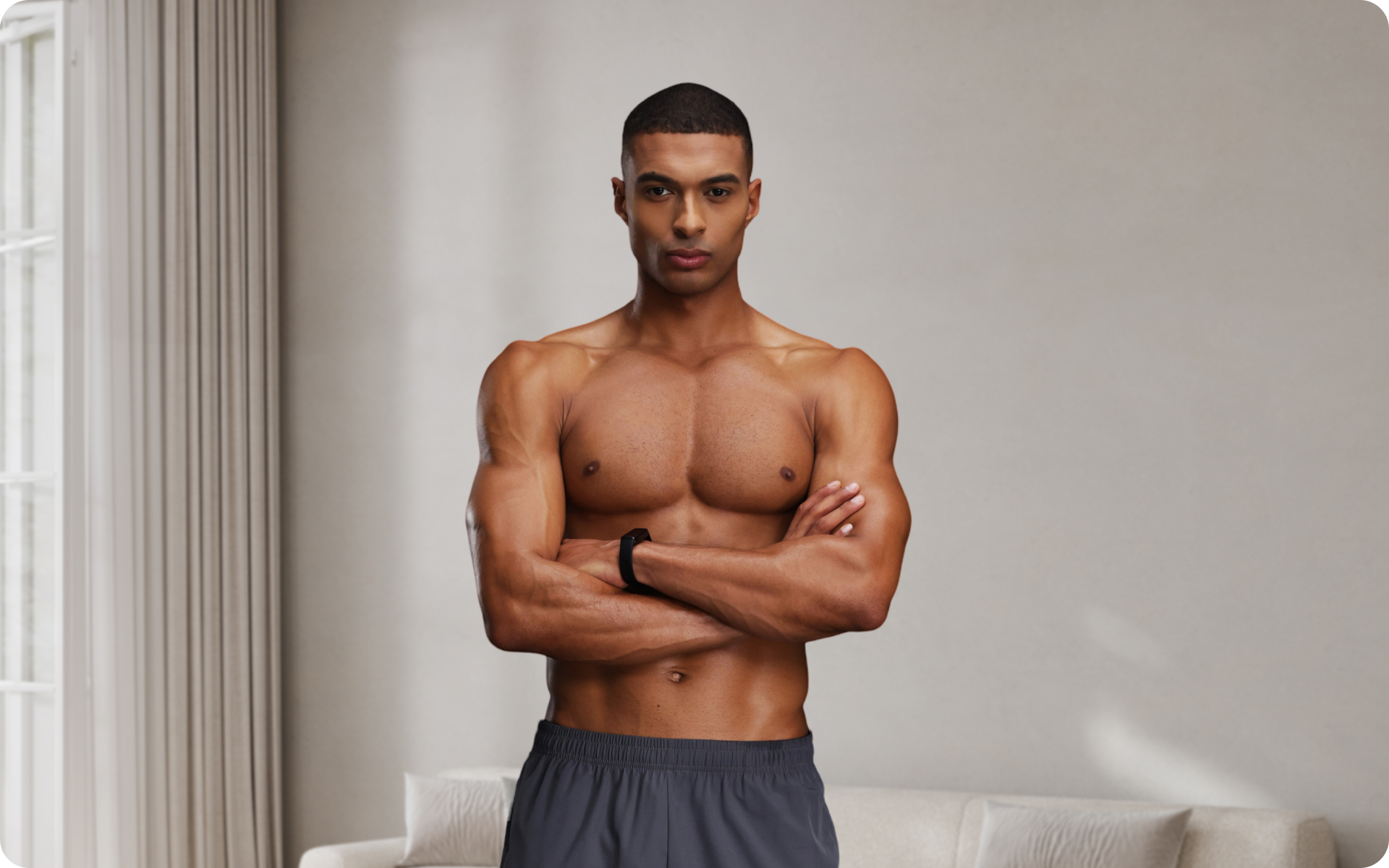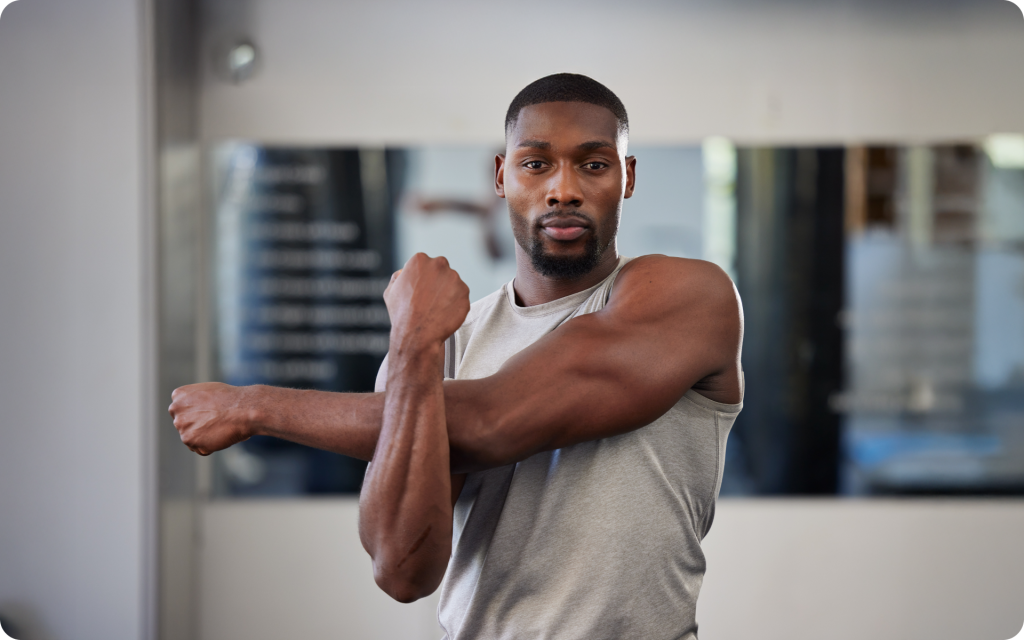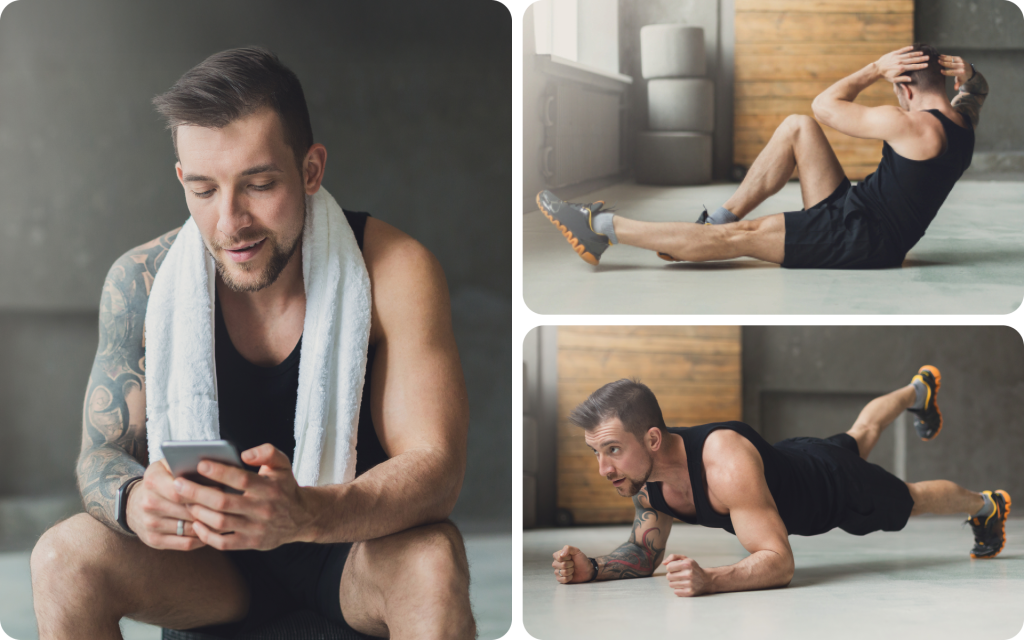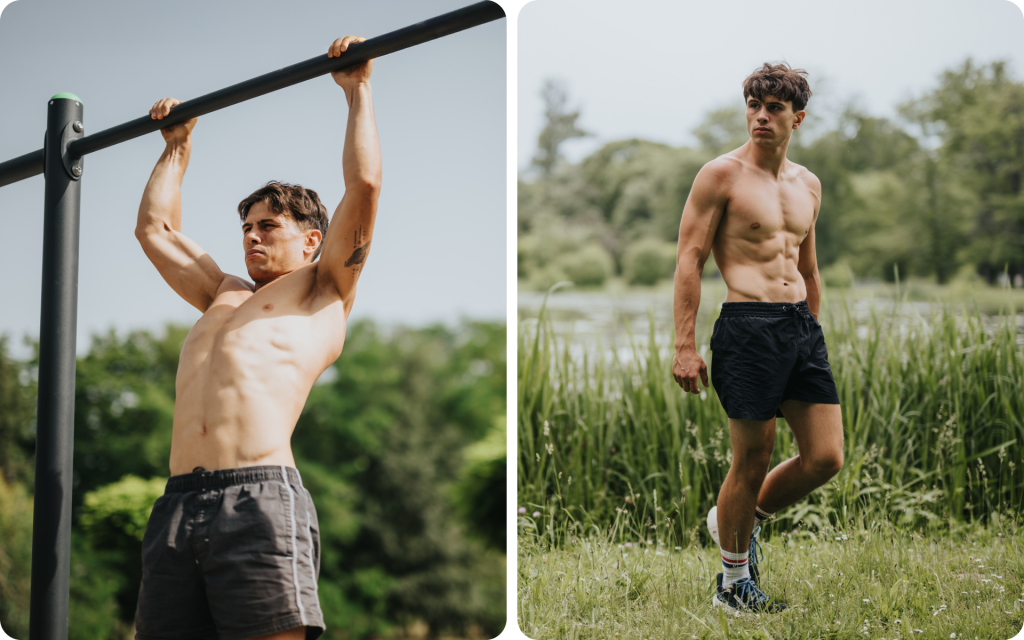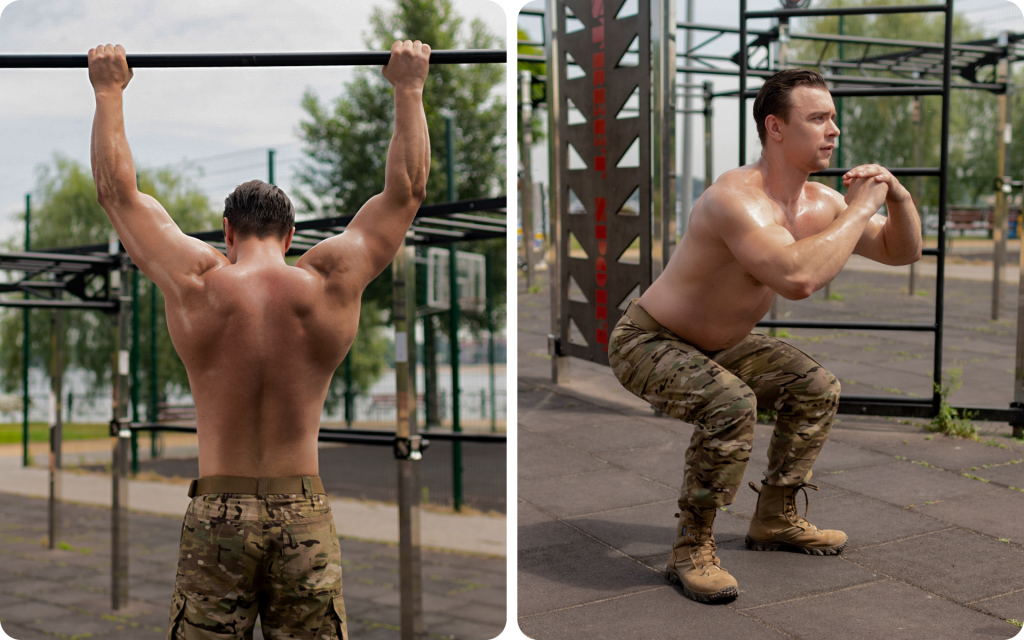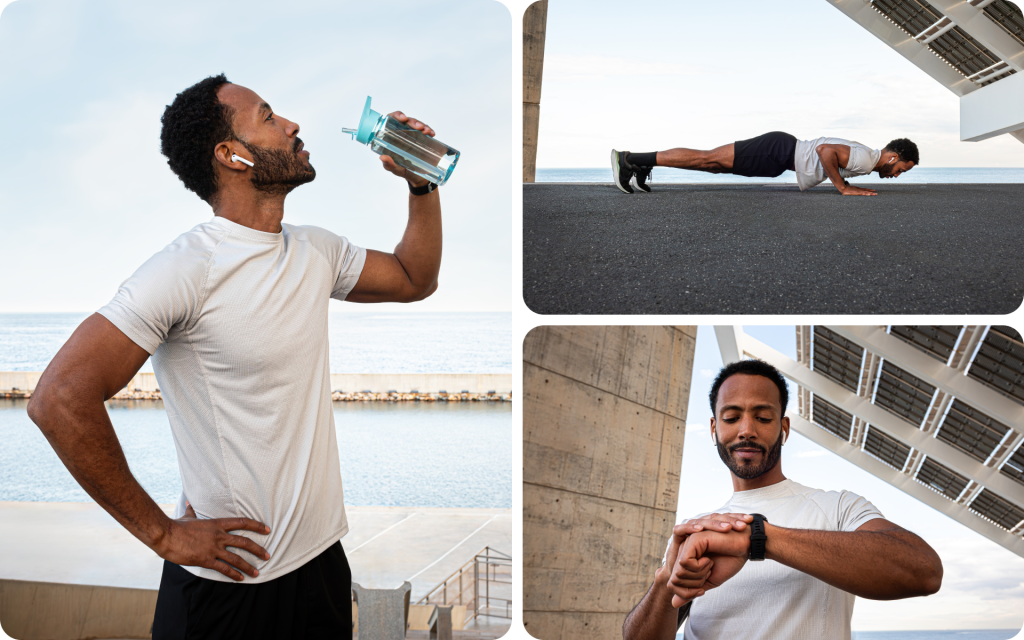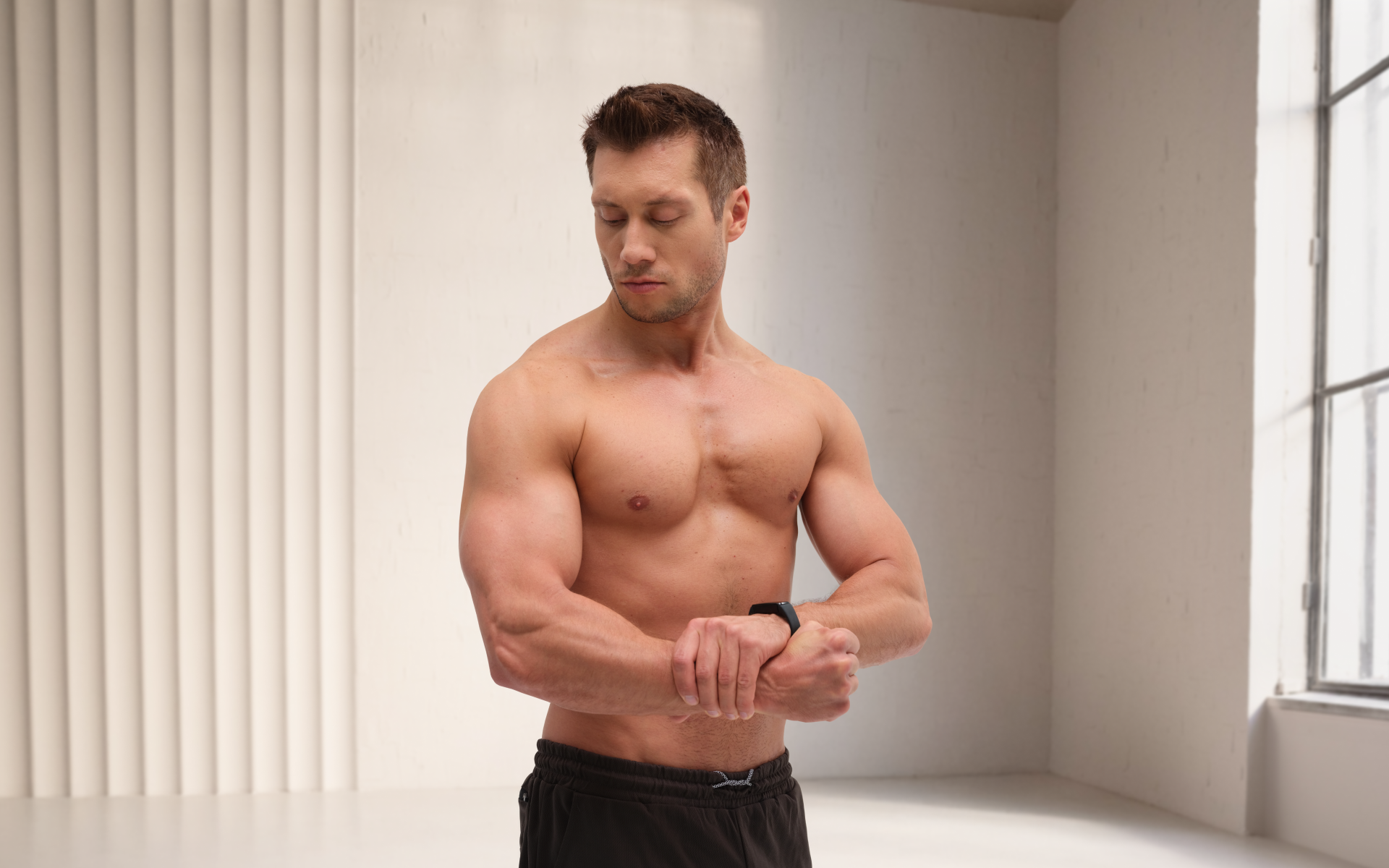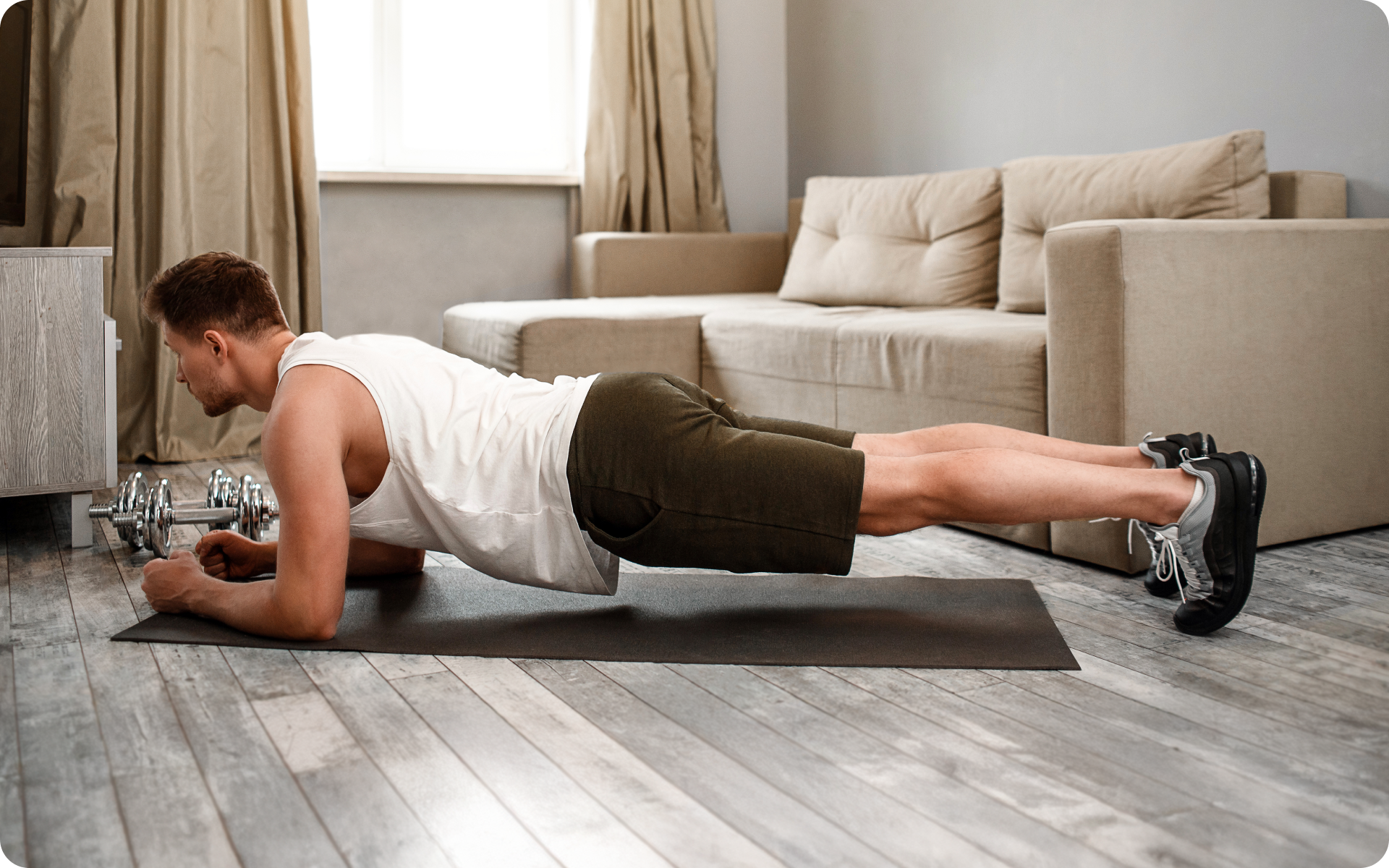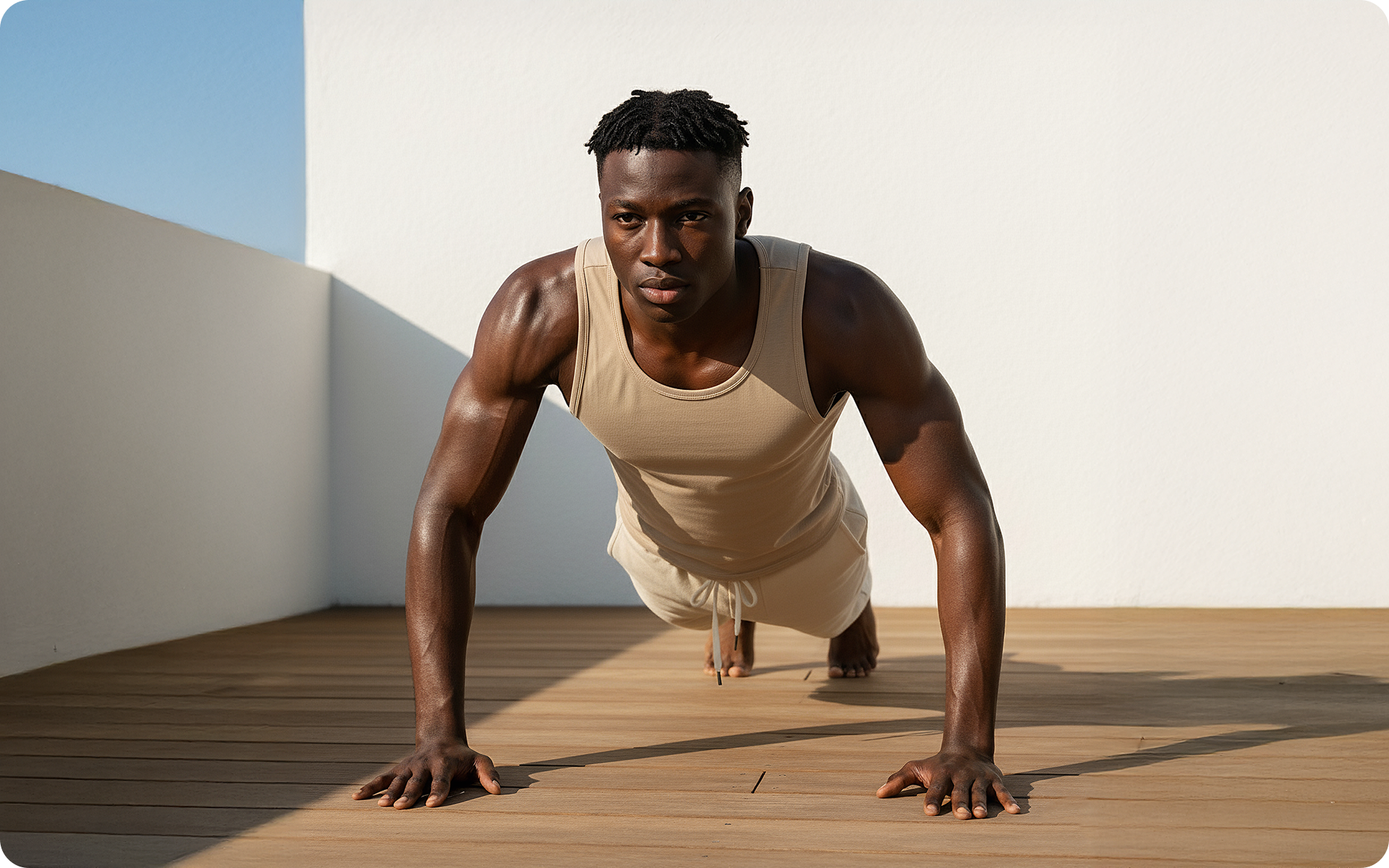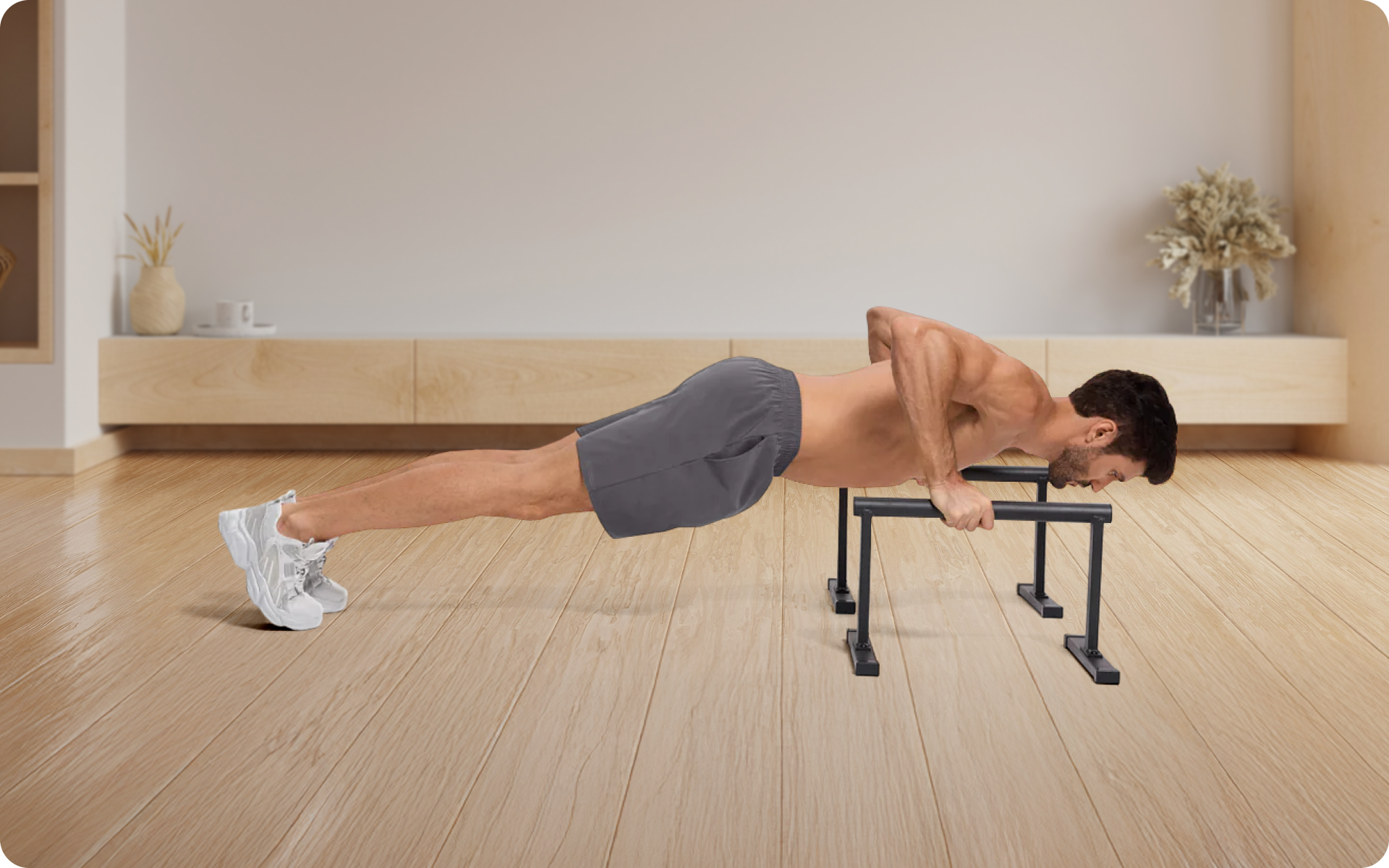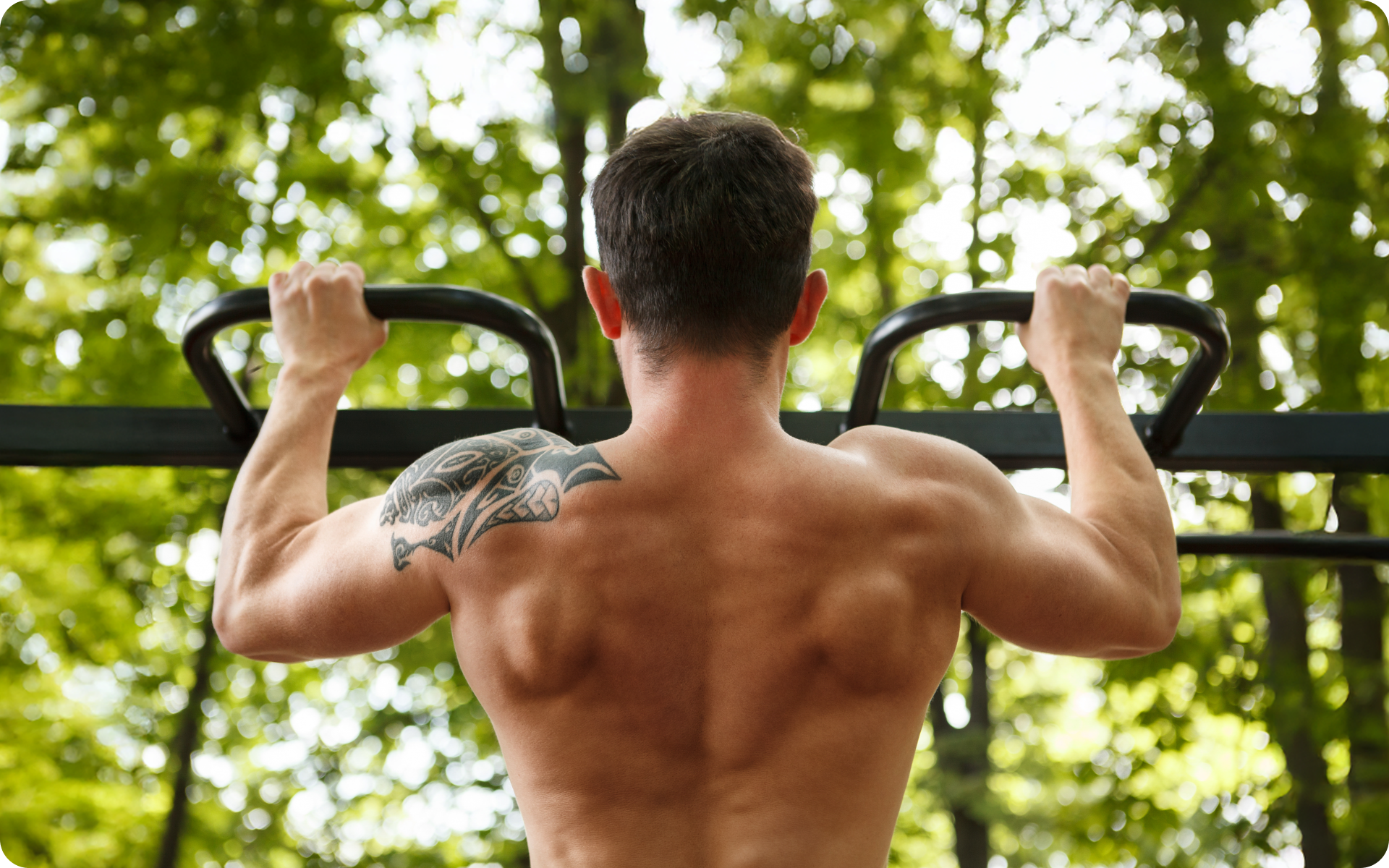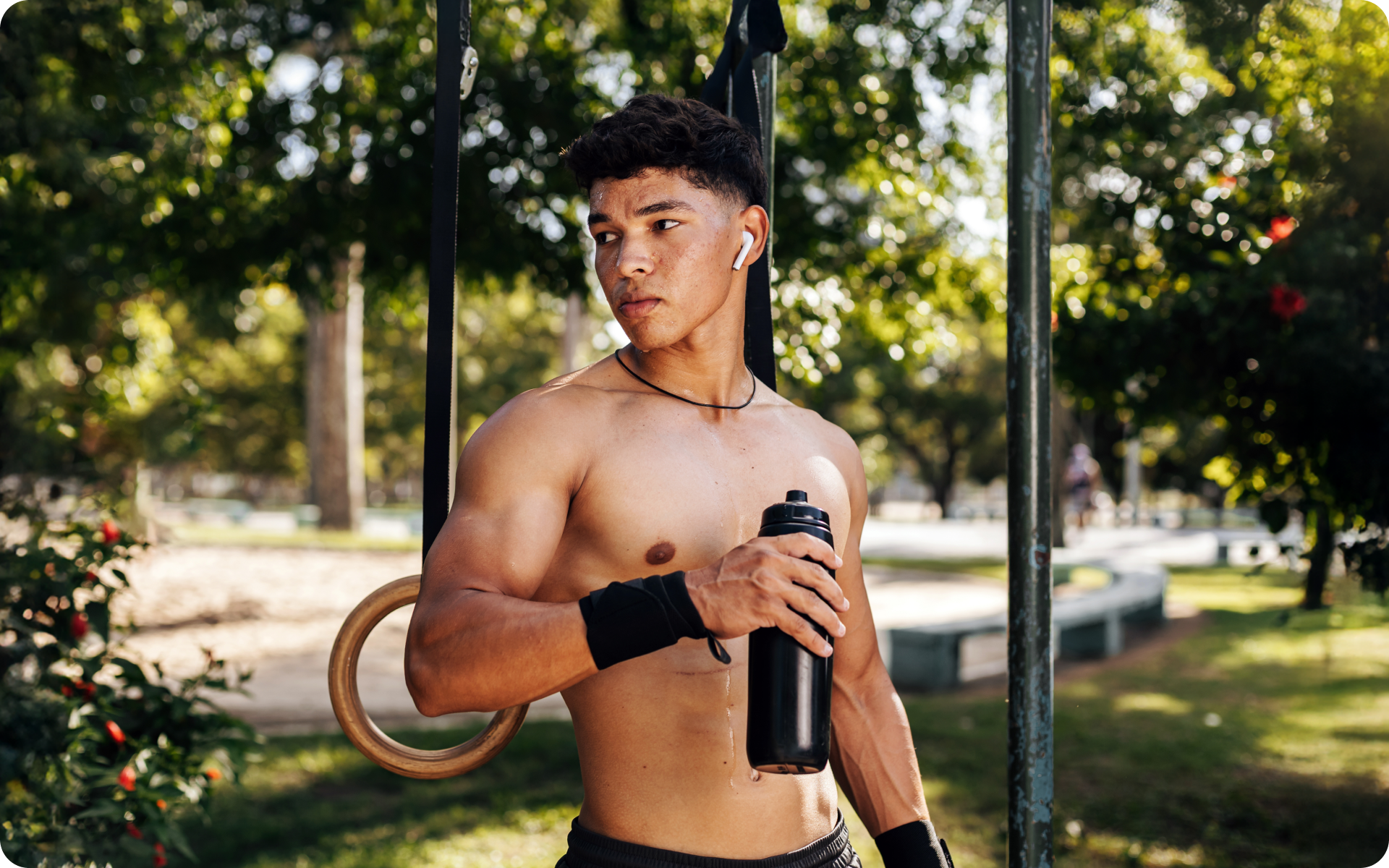Calisthenics uses your body weight as resistance to build strength, flexibility, and endurance. Think push-ups, pull-ups, and squats. Unlike weight training, which involves lifting external loads such as dumbbells or barbells, calisthenics relies on moving and controlling one’s own body (1).
Both methods can improve fitness, but they approach it in different ways.
Calisthenics emphasizes functional strength and body control, often engaging multiple muscle groups at once (1).
We’ve crafted this guide to help you get started with a simple, full body calisthenics workout routine for beginners.
Do Calisthenics Build Size In Practitioners?
Calisthenics can build muscle size, to some extent.
Muscle growth, or hypertrophy, occurs when your muscles experience enough tension to trigger adaptation (2).
With weight-based training, increasing the weight makes this progressive overload straightforward. Calisthenics, however, relies on your body weight.
It requires modifying exercises to increase difficulty, such as elevating your feet in push-ups or switching to one-arm variations (3).
While calisthenics may lack the maximal overload of heavy weightlifting, it can still induce significant muscle growth, especially for beginners. It leverages compound movements, which engage multiple muscle groups at once, stimulating overall development (1).
That said, advanced lifters may find it more challenging to continue progressing with bodyweight alone, as adding resistance becomes increasingly tricky.
Ultimately, calisthenics can help build muscle size, but it requires creativity for continued progression.
Can You Get A Good Body With Just Calisthenics?
What makes a body “good” is subjective, but calisthenics can improve strength, mobility, and aesthetics.
These exercises emphasize functional strength, helping you develop muscles that are not just strong but also resilient and adaptable in real-world movements.
The reliance on compound exercises, like pull-ups and dips, promotes balanced development across major muscle groups, creating a physique that’s powerful and proportionate (1).
However, achieving a specific “look” solely through calisthenics depends on variables such as genetics, consistency, and diet. You may not achieve the bulk appearance often associated with heavy lifting, but you can develop a lean, defined body.
Where calisthenics truly shines is in enhancing body control, core strength, and athleticism. Combining it with proper nutrition and adequate recovery can undoubtedly yield a strong, capable, and aesthetically pleasing physique (1).
When it comes to weight loss, progress is made by inches, not miles, so it’s much harder to track and a lot easier to give up. The BetterMe: Health Coaching app is your personal trainer, nutritionist, and support system all in one. Start using our app to stay on track and hold yourself accountable!
Can You Get A Full Body Workout With Calisthenics?
Yes, calisthenics naturally lends itself to full-body workouts. Because many exercises are compound movements, they engage multiple muscle groups simultaneously (1).
- For example, push-ups engage your chest, shoulders, triceps, and core.
- Pull-ups target your back, biceps, and shoulders.
- Squats and lunges train your lower body while also activating stabilizing muscles in your core.
So, what is a balanced full body calisthenics routine for progress?
You or a professional trainer can tailor a calisthenics routine to include all major muscle groups for balanced training. For instance, a calisthenics full body routine session could combine push-ups, pull-ups, squats, and planks for a comprehensive workout.
Additionally, calisthenics integrates flexibility and mobility (5), which many individuals can neglect in other forms of training. While it can’t perfectly mimic the isolation of weight training, it provides a well-rounded approach to fitness that strengthens not just the body, but also its coordination and balance.
Read more: Calisthenics Workout Plan for Men Who Want to Get Lean
What Are The Most Powerful Full Body Calisthenics Exercises?
Push-Ups (Chest, Shoulders, Triceps, Core)
Push-ups are a foundational calisthenics exercise that strengthens the upper body while engaging the core as a stabilizer. The movement involves horizontal pushing, primarily working the chest, shoulders, and triceps (4).
Steps to execute:
- Begin in a high plank position with your hands shoulder-width apart.
- Engage your core and maintain a neutral spine.
- Lower your body by bending your elbows until your chest nearly touches the ground.
- Push back up to the starting position, keeping your torso straight throughout.
Pull-Ups (Back, Biceps, Shoulders)
Pull-ups are a vertical pulling exercise that targets the upper back, including the latissimus dorsi, biceps, and rear shoulders. This movement enhances pulling strength and builds upper body mass (6).
Steps to execute:
- Grip a pull-up bar with your palms facing forward, slightly wider than shoulder-width.
- Engage your core and pull yourself upward, leading with your chest.
- Squeeze your shoulder blades together as your chin reaches above the bar.
- Lower yourself back to the starting position in a controlled manner.
Bodyweight Squats (Quads, Glutes, Hamstrings, Core)
Squats strengthen key lower-body muscles while improving hip mobility, balance, and posture. They rely on a vertical pushing movement, allowing natural recruitment of stabilizing muscles (7).
Steps to execute:
- Stand with your feet shoulder-width apart and toes slightly pointed outward.
- Push your hips back and bend your knees to lower your body as if you were sitting in a chair.
- Keep your chest upright and engage your core
- Drive through your heels to stand back up to the starting position.
Dips (Chest, Triceps, Shoulders)
Dips focus on the pushing muscles of the upper body, particularly the chest and triceps, while also engaging the shoulders. These are effective for building strength and stability (8).
Steps to execute:
- Hold onto parallel bars or sturdy surfaces with your arms fully extended.
- Lower your body by bending your elbows until your shoulders are below your elbows.
- Push yourself back to the starting position without locking your elbows at the top.
Plank (Core, Shoulders)
The plank is an isometric exercise that strengthens the core, shoulders, and stabilizer muscles. It builds endurance and improves posture by maintaining spinal alignment (9).
Steps to execute:
- Lie face down and prop yourself up on your forearms and toes.
- Maintain a straight line from your head to your heels, keeping your core tight.
- Hold this position while avoiding sagging or arching your back.
Bulgarian Split Squats (Quads, Glutes, Hamstrings)
This unilateral lower body exercise enhances balance and coordination while targeting individual leg muscles. It focuses on the quads, glutes, and hamstrings (10).
Steps to execute:
- Stand a few feet in front of a bench or elevated surface, and place one foot behind you on the bench or surface.
- Lower your body by bending the front knee while keeping your back upright.
- Push through the heel of your front foot to return to the starting position.
- Switch legs and repeat.
Burpees (Full Body)
Burpees are a high-intensity, full-body exercise that combines strength and cardiovascular training.
They work the arms, chest, legs, and core while boosting heart rate (11).
Steps to execute:
- Stand tall, then squat down and place your hands on the ground in front of you.
- Kick your feet back to assume a high plank position.
- Perform a push-up, then jump your feet back toward your hands.
- Explosively jump up into the air, reaching your arms overhead.
Read more: Calisthenics for Skinny Guys: 8 Exercises to Build Muscle
What Is A Solid Example Of A Full Body Calisthenics Routine?
Here is a beginner-friendly full-body calisthenics routine using the exercises discussed above.
Perform the routine 2–3 times a week, allowing at least one rest day in between:
- Burpees: 2 sets of 8–10 reps (focus on form and controlled movement)
- Pull-Ups: 3 sets of 5–8 reps (use a resistance band for assistance if needed)
- Bodyweight Squats: 3 sets of 12–15 reps
- Push-Ups: 3 sets of 10–12 reps
- Bulgarian Split Squats: 3 sets of 8–10 reps per leg
- Dips: 3 sets of 8–10 reps
- Plank: 3 sets of 20–30 seconds hold
Rest for 60–90 seconds between sets. Gradually increase reps or progressions as your strength improves.
How Long Should A Full Body Calisthenics Workout Be?
The length of a full-body calisthenics workout varies, but for most beginners, 30–45 minutes is an effective range. This timing allows for a comprehensive workout covering all major muscle groups without overextending or risking burnout.
Intensity plays a crucial role in determining duration. For example, high-intensity circuits with minimal rest may require shorter sessions of 20–30 minutes, while moderate-paced workouts with longer breaks can stretch closer to 45 minutes.
Rest periods between sets are another key factor.
Beginners may rest 60–90 seconds between exercises to recover sufficiently, while more advanced practitioners might opt for shorter rest periods to maintain intensity.
Ultimately, the workout should align with your fitness level, goals, and ability to maintain good form throughout. Quality is just as important as quantity in calisthenics.
Is It Ok To Do Full Body Calisthenics Everyday?
Training daily with full-body calisthenics is not advisable.
It puts you at risk of overtraining and limits your recovery, both of which are detrimental to your progress.
When you exercise, especially with resistance-based movements like calisthenics, you cause microtears in your muscle fibers. This damage triggers a repair process during rest, where your body rebuilds the fibers stronger and more resistant (2).
Beyond muscles, your nervous system also plays a significant role.
Movements like push-ups and pull-ups require communication between your brain and muscles. Overtraining can overload the nervous system, leading to fatigue and a decline in coordination and strength (12).
Consistently skipping recovery increases the risk of overtraining.
It isn’t just about feeling sore or tired. Overtraining can lead to chronic fatigue, a weakened immune system (which makes you more prone to illness), poor sleep quality, and even mental health issues like irritability or burnout (12).
Beginners can amplify these risks because the body is still adapting to the new demands of exercise. Ignoring these signals can hinder progress or even lead to injury.
That said, with proper strategies, you can create a sustainable routine for frequent exercise (maximum 4 days a week):
- Alternate Intensity Levels:
Not every workout needs to push you to your limits.
Structure your week by varying intensity. For example, on some days, focus on high-intensity circuits, while on others, emphasize lower-intensity exercises, such as planks or stretches. This approach allows certain muscle groups and your nervous system to recover without halting your exercise streak.
- Active Recovery
Incorporating light activities on “rest” days keeps movement consistent while promoting recovery. Practices like yoga, stretching, or a casual walk can boost circulation, aiding muscle repair and reducing tightness without adding strain (13).
- Monitor Overtraining Symptoms
Pay close attention to how your body feels. Persistent soreness, difficulty sleeping, irritability, or feelings of weakness are all signs to be aware of (14). If they appear, scale back your sessions and prioritize rest.
- Periodization
Use a training strategy that cycles through phases of varying intensities and volumes.
For example, perform more challenging workouts for 4 weeks, then take a lighter week focused on recovery. This structured variability prevents chronic stress on your body.
- Optimize Recovery
While training frequency is important, factors like nutrition, sleep, and hydration are equally critical. Ensure you consume enough protein and nutrients to fuel muscle repair, and aim for 7–9 hours of quality sleep each night.
What Results Can You Expect From Daily Full-Body Calisthenics?
Daily full-body calisthenics is rarely a sustainable or optimal approach to fitness.
Your body needs rest to recover and adapt.
Frequent practice, however, done correctly, comes with significant benefits.
Here’s what you can expect:
Physical Benefits
Calisthenics builds strength and endurance through functional, compound movements that engage multiple muscle groups simultaneously. These movements engage large muscle groups and improve coordination. Over time, you’ll notice an improvement in your posture due to the emphasis on core stability. Increased flexibility is another advantage, as exercises like squats and planks improve joint mobility and range of motion (5).
You can also achieve a lean, defined physique since calisthenics often combines strength and cardio. Frequent sessions can aid in fat loss and promote muscle tone, especially when paired with a balanced diet (5).
However, achieving dramatic muscle hypertrophy may be more challenging with bodyweight exercises alone.
Neurological Benefits
Frequent calisthenics sharpens neuromuscular coordination, which is the brain’s ability to communicate with muscles (15) efficiently. Movements like push-ups or pull-ups require balance, stability, and precise muscle activation. Practicing these movements trains your nervous system to function better over time.
Bodyweight exercises also improve proprioception (16), which is your body’s awareness of its position in space. This heightened sense of balance and control not only makes you stronger but also helps you move more efficiently in daily life and sports.
Reasons why BetterMe is a safe bet: a wide range of calorie-blasting workouts, finger-licking recipes, 24/7 support, challenges that’ll keep you on your best game, and that just scratches the surface! Start using our app and watch the magic happen.
Mental Benefits
Regular calisthenics full body workout routines can enhance mental well-being.
Exercise triggers the release of endorphins, which are natural mood boosters.
It can also reduce stress by lowering cortisol levels and increasing feelings of relaxation (17).
Consistency with a full body strength training routine builds discipline and confidence.
Mastering a challenging move, like a pull-up or dip, is a testament to growth and resilience. The accessible, equipment-free nature of calisthenics makes it easy to maintain a full body calisthenics workout routine, which can contribute to a stronger sense of accomplishment and self-efficacy. A full body workout at home without equipment is possible with calisthenics.
Yes, it’s okay to focus solely on a full body calisthenics routine at home. These exercises improve strength, flexibility, and endurance using only your body weight. They develop functional strength and coordination, which translates well to everyday movements or sports. However, if your goal is maximum muscle hypertrophy or heavy lifting capability, additional resistance training outside of calisthenics may complement your routine. Combining calisthenics and gym training can offer the best of both worlds. Calisthenics improves functional strength, body control, and mobility, while weightlifting using gym equipment can add progressive overload for muscle growth. Together, the two exercise forms create a balanced, versatile program that supports various fitness goals. Yes, calisthenics can help you achieve a lean and defined physique. These exercises often combine strength and cardio, improving muscle tone while burning calories. However, achieving a “ripped” look also depends heavily on maintaining a calorie-controlled, high-protein diet and ensuring consistent effort in your workouts.Frequently Asked Questions
Is it okay to only do calisthenics?
Can I combine calisthenics and gym?
Can I get ripped with calisthenics?
The Bottom Line
A well-structured full body calisthenics routine can help you build strength, improve mobility, and achieve a lean, defined physique. It’s a versatile and functional form of exercise that requires no equipment, making it accessible to both beginners and advanced athletes. However, focus on quality over quantity.
Recovery is crucial for preventing overtraining, supporting muscle repair, and boosting performance. By incorporating varied intensity levels, rest days, and active recovery, you can maximize the physical, neurological, and mental benefits of calisthenics.
DISCLAIMER:
This article is intended for general informational purposes only and does not serve to address individual circumstances. It is not a substitute for professional advice or help and should not be relied on for making any kind of decision-making. Any action taken as a direct or indirect result of the information in this article is entirely at your own risk and is your sole responsibility.
BetterMe, its content staff, and its medical advisors accept no responsibility for inaccuracies, errors, misstatements, inconsistencies, or omissions and specifically disclaim any liability, loss or risk, personal, professional or otherwise, which may be incurred as a consequence, directly or indirectly, of the use and/or application of any content.
You should always seek the advice of your physician or other qualified health provider with any questions you may have regarding a medical condition or your specific situation. Never disregard professional medical advice or delay seeking it because of BetterMe content. If you suspect or think you may have a medical emergency, call your doctor.
SOURCES:
- Bodyweight Training for Muscular Strength & Endurance (2022, juniperpublishers.com)
- How do muscles grow? (n.d., unm.edu)
- Effect of Progressive Calisthenic Push-up Training on Muscle Strength and Thickness (2018, pubmed.ncbi.nlm.nih.gov)
- Pushups (n.d., physio-pedia.com)
- From Strength to Flexibility: The Comprehensive Benefits of Calisthenics (2024, forum.facmedicine.com)
- Electromyographic analysis of muscle activation during pull-up variations (2017, sciencedirect.com)
- Effects of progressive body-weight versus barbell back squat training on strength, hypertrophy and body fat among sedentary young women (2023, nature.com)
- Bench, Bar, and Ring Dips: Do Kinematics and Muscle Activity Differ? (2022, mdpi.com)
- Why You Should Start Doing Planks (2021, health.clevelandclinic.org)
- Muscle activity of Bulgarian squat. Effects of additional vibration, suspension and unstable surface (2019, pmc.ncbi.nlm.nih.gov)
- The Influence of Burpee on Endurance and Short-Term Memory of Adolescents (2022, mdpi.com)
- Overtraining Syndrome as a Complex Systems Phenomenon (2022, frontiersin.org)
- A Systematic Review on the Effectiveness of Active Recovery Interventions on Athletic Performance of Professional-, Collegiate-, and Competitive-Level Adult Athletes (2019, journals.lww.com)
- Diagnosing Overtraining Syndrome: A Scoping Review (2021, journals.sagepub.com)
- The Effect of Breaking Up Sedentary Time with Calisthenics on Neuromuscular Function: A Preliminary Study (2022, mdpi.com)
- Effects of calisthenics and Pilates exercises on coordination and proprioception in adult women: a randomized controlled trial (2012, pubmed.ncbi.nlm.nih.gov)
- Role of Physical Activity on Mental Health and Well-Being: A Review (2023, pmc.ncbi.nlm.nih.gov)
